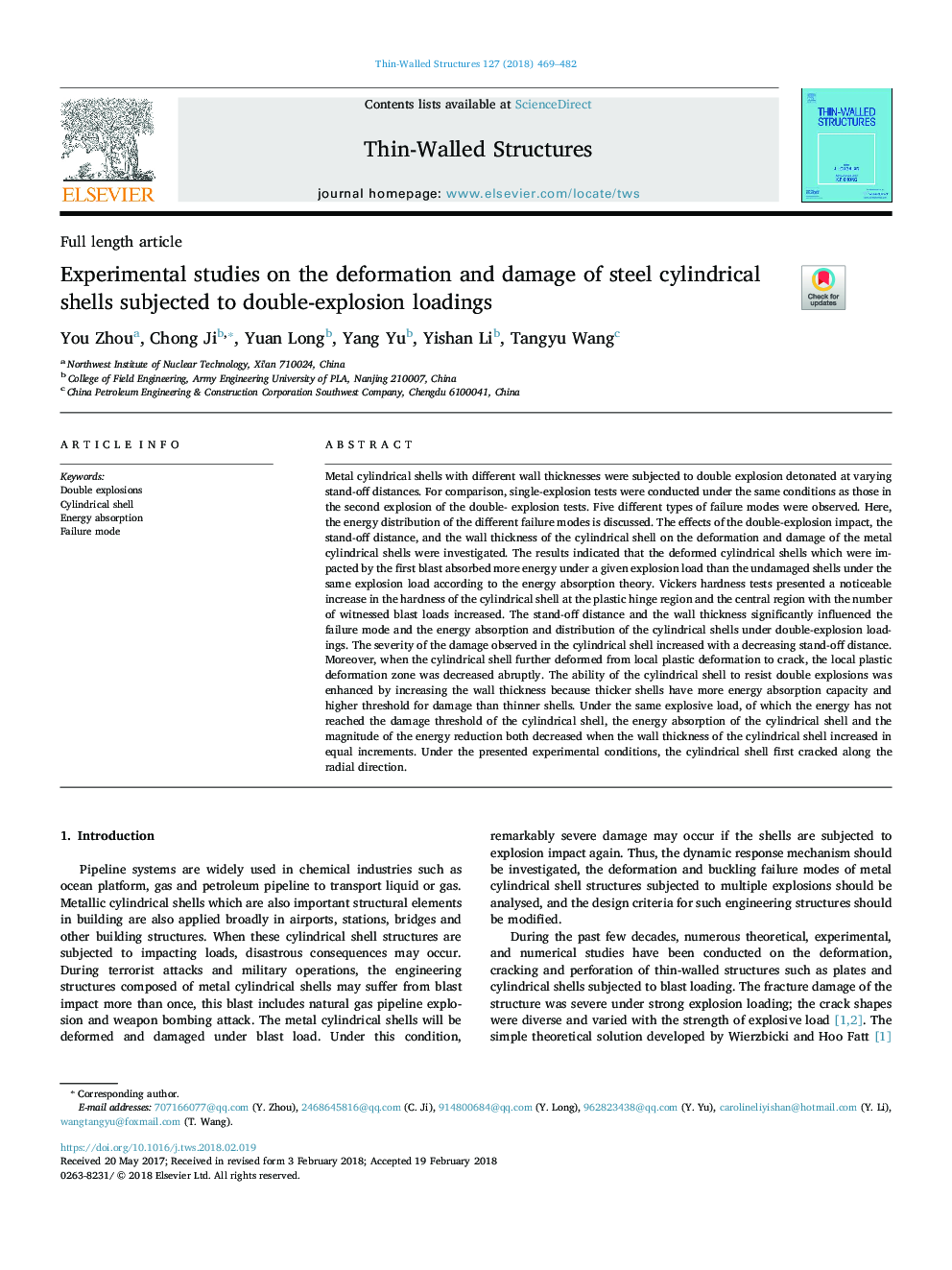| کد مقاله | کد نشریه | سال انتشار | مقاله انگلیسی | نسخه تمام متن |
|---|---|---|---|---|
| 6777720 | 1432064 | 2018 | 14 صفحه PDF | دانلود رایگان |
عنوان انگلیسی مقاله ISI
Experimental studies on the deformation and damage of steel cylindrical shells subjected to double-explosion loadings
ترجمه فارسی عنوان
مطالعات تجربی در مورد تغییر شکل و آسیب پوسته های استوانه ای فولادی تحت بارگذاری دو انفجار
دانلود مقاله + سفارش ترجمه
دانلود مقاله ISI انگلیسی
رایگان برای ایرانیان
کلمات کلیدی
دو انفجار، پوسته سیلندر، جذب انرژی، حالت شکست
ترجمه چکیده
پوسته های فلزی استوانه ای با ضخامت دیواره های مختلف، در انفجار دو انفجار در فاصله های مختلف ایستاده قرار گرفته اند. برای مقایسه، آزمایشهای تک انفجاری تحت شرایط مشابه با انفجار دوم آزمایشهای دو انفجار انجام شد. پنج نوع مختلف حالت های شکست مشاهده شد. در اینجا، توزیع انرژی حالت های شکست مختلف مورد بحث قرار می گیرد. اثرات اثر دو انفجار، فاصله ایستادگی و ضخامت دیواره پوسته استوانه ای بر تغییر شکل و آسیب پوسته های استوانه ای فلزی مورد بررسی قرار گرفت. نتایج نشان داد که پوسته های استوانه ای تغییر شکل که توسط اولین انفجار تحت تاثیر قرار گرفت، انرژی بیشتری را تحت بار انفجار داده شده نسبت به پوسته های ناپدید شده تحت بار انفجار مشابه با توجه به نظریه جذب انرژی جذب کردند. آزمون سختی ویکرز افزایش قابل توجهی در سختی پوسته استوانه ای در منطقه لولای پلاستیکی و منطقه مرکزی با تعداد بارهای انفجار شاهد افزایش یافت. فاصله ایستادگی و ضخامت دیواره به طور قابل ملاحظه ای از حالت شکست و جذب و توزیع انرژی پوسته های استوانه ای تحت بارهای دو انفجار تأثیر می گذارد. شدت آسیب مشاهده شده در پوسته استوانه ای با کاهش فاصله ایستاده افزایش می یابد. علاوه بر این، هنگامی که پوسته استوانه ای بیشتر از تغییر شکل پلاستیک موضعی به کرک تغییر می کند، ناحیه تغییر شکل پلاستیک محلی به طور ناگهانی کاهش می یابد. توانایی پوسته استوانه ای برای مقاومت در برابر انفجار های دوگانه با افزایش ضخامت دیواره افزایش یافته است، زیرا پوسته های ضخیم دارای ظرفیت جذب انرژی بیشتری و آستانه بالاتر برای آسیب نسبت به پوسته های نازک تر است. تحت همان بار انفجاری که انرژی آن به آستانه آسیب پوسته استوانه ای رسیده است، جذب انرژی پوسته استوانه ای و مقدار کاهش انرژی هر دو کاهش می یابد زمانی که ضخامت دیواره پوسته استوانه ای با افزایش برابر افزایش می یابد. تحت شرایط آزمایشی ارائه شده، پوسته استوانه ای ابتدا در امتداد جهت شعاعی ترک خورده است.
موضوعات مرتبط
مهندسی و علوم پایه
سایر رشته های مهندسی
مهندسی عمران و سازه
چکیده انگلیسی
Metal cylindrical shells with different wall thicknesses were subjected to double explosion detonated at varying stand-off distances. For comparison, single-explosion tests were conducted under the same conditions as those in the second explosion of the double- explosion tests. Five different types of failure modes were observed. Here, the energy distribution of the different failure modes is discussed. The effects of the double-explosion impact, the stand-off distance, and the wall thickness of the cylindrical shell on the deformation and damage of the metal cylindrical shells were investigated. The results indicated that the deformed cylindrical shells which were impacted by the first blast absorbed more energy under a given explosion load than the undamaged shells under the same explosion load according to the energy absorption theory. Vickers hardness tests presented a noticeable increase in the hardness of the cylindrical shell at the plastic hinge region and the central region with the number of witnessed blast loads increased. The stand-off distance and the wall thickness significantly influenced the failure mode and the energy absorption and distribution of the cylindrical shells under double-explosion loadings. The severity of the damage observed in the cylindrical shell increased with a decreasing stand-off distance. Moreover, when the cylindrical shell further deformed from local plastic deformation to crack, the local plastic deformation zone was decreased abruptly. The ability of the cylindrical shell to resist double explosions was enhanced by increasing the wall thickness because thicker shells have more energy absorption capacity and higher threshold for damage than thinner shells. Under the same explosive load, of which the energy has not reached the damage threshold of the cylindrical shell, the energy absorption of the cylindrical shell and the magnitude of the energy reduction both decreased when the wall thickness of the cylindrical shell increased in equal increments. Under the presented experimental conditions, the cylindrical shell first cracked along the radial direction.
ناشر
Database: Elsevier - ScienceDirect (ساینس دایرکت)
Journal: Thin-Walled Structures - Volume 127, June 2018, Pages 469-482
Journal: Thin-Walled Structures - Volume 127, June 2018, Pages 469-482
نویسندگان
You Zhou, Chong Ji, Yuan Long, Yang Yu, Yishan Li, Tangyu Wang,
